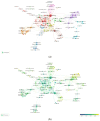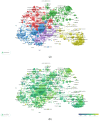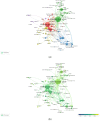Global Trends in Diabetic Foot Research (2004-2023): A Bibliometric Study Based on the Scopus Database
- PMID: 40283692
- PMCID: PMC12026514
- DOI: 10.3390/ijerph22040463
Global Trends in Diabetic Foot Research (2004-2023): A Bibliometric Study Based on the Scopus Database
Abstract
Diabetic foot is one of the leading complications of diabetes mellitus that affects millions of people around the world and involves the presence of ulcers, infections, tissue destruction, and loss of sensation and can even lead to limb amputation. This research explores trends in diabetic foot global research through a bibliometric analysis of publications indexed in Scopus in the period 2004-2023. A total of 7136 documents were analysed using Excel, Python, Biblioshiny, and VOSviewer. Scientific production has multiplied by a factor of 6.6 from the first to the last year analysed. Armstrong D.G. is the most productive and cited author. China is the most productive country, and the United States is the most cited. The most productive journal is the International Journal of Lower Extremity Wounds, and the most cited journal is Diabetes Care. Research on diabetic foot is mainly focused on the complications of diabetes mellitus; the treatment and healing of wounds; infections; and epidemiology and patient care. Infections and antibiotic treatment are emerging topics, while deep learning and machine learning are among the niche topics in this area of knowledge. The present study allows us to identify current trends and future directions of research in diabetic foot.
Keywords: Scopus; bibliometric analysis; diabetic foot; research trends.
Conflict of interest statement
The authors declare no conflicts of interest.
Figures












Similar articles
-
Knowledge mapping of diabetic foot research based on Web of Science database: A bibliometric analysis.Medicine (Baltimore). 2023 Jun 30;102(26):e34053. doi: 10.1097/MD.0000000000034053. Medicine (Baltimore). 2023. PMID: 37390232 Free PMC article. Review.
-
How far has diabetes-related foot disease research progressed in Australia? A bibliometric review (1970-2023).J Foot Ankle Res. 2024 Jun;17(2):e12012. doi: 10.1002/jfa2.12012. J Foot Ankle Res. 2024. PMID: 38627979 Free PMC article. Review.
-
Global research trends and future directions in diabetic macular edema research: A bibliometric and visualized analysis.Medicine (Baltimore). 2024 Jun 21;103(25):e38596. doi: 10.1097/MD.0000000000038596. Medicine (Baltimore). 2024. PMID: 38905408 Free PMC article.
-
Evolution and global research trends of immunity in diabetic nephropathy: a bibliometric and visual analysis from 2004 to 2023.Int Urol Nephrol. 2024 Oct;56(10):3307-3321. doi: 10.1007/s11255-024-04081-x. Epub 2024 May 17. Int Urol Nephrol. 2024. PMID: 38758346 Free PMC article.
-
Worldwide Research Trends on Diabetic Foot Ulcers (2004-2020): Suggestions for Researchers.J Diabetes Res. 2022 Jan 27;2022:7991031. doi: 10.1155/2022/7991031. eCollection 2022. J Diabetes Res. 2022. PMID: 35127951 Free PMC article.
References
-
- Staniszewska A., Game F., Nixon J., Russell D., Armstrong D.G., Ashmore C., Bus S.A., Chung J., Chuter V., Dhatariya K., et al. Development of a Core Outcome Set for Studies Assessing Interventions for Diabetes-Related Foot Ulceration. Diabetes Care. 2024;47:1958–1968. doi: 10.2337/dc24-1112. - DOI - PMC - PubMed
-
- Sun H., Saeedi P., Karuranga S., Pinkepank M., Ogurtsova K., Duncan B.B., Stein C., Basit A., Chan J.C.N., Mbanya J.C., et al. IDF Diabetes Atlas: Global, Regional and Country-Level Diabetes Prevalence Estimates for 2021 and Projections for 2045. Diabetes Res. Clin. Pract. 2022;183:109119. doi: 10.1016/j.diabres.2021.109119. - DOI - PMC - PubMed
-
- Normahani P., Shalhoub J. Diabetic Foot Disease. Surgery. 2024;42:834–841. doi: 10.1016/j.mpsur.2024.08.004. - DOI
Publication types
MeSH terms
LinkOut - more resources
Full Text Sources
Medical

